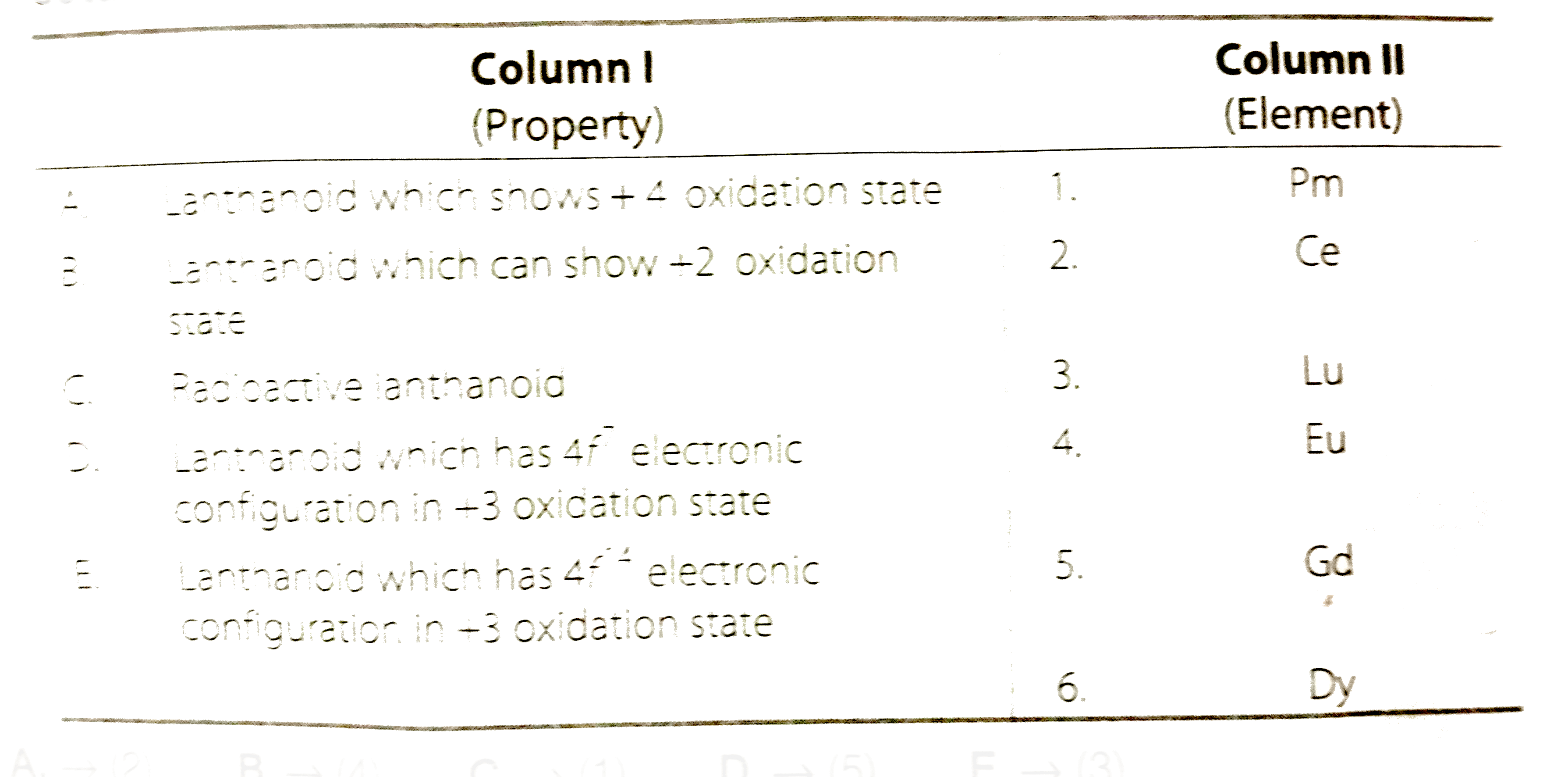Match the properties given in Column I with the reansition elements given in Column II and select the correct answer using the code below the lists :
ColumnIColumnII(Property)(Transition elements)(a)Highest oxidation state(p) Cr.(b)Highest density(q) Os.(c)Element with maximum unparied electrons.(r) Tc.(d)Radioactive transition element(s) Cu.
Code :
(a)(b)(c)(d)qqpr
(a)(b)(c)(d)qpsr
(a)(b)(c)(d)pqrs
(a)(b)(c)(d)rsqp
The correct Answer is:1
To solve the problem of matching the properties given in Column I with the transition elements in Column II, we will analyze each property and identify the corresponding transition element.
1. Identify the Highest Oxidation State (Property a):
- The highest oxidation state among transition elements is +8, which is exhibited by Osmium (Os).
- Match: a → q (Osmium)
2. Identify the Highest Density (Property b):
- The element with the highest density is also Osmium (Os), which has a density of 22.57 g/cm³.
- Match: b → q (Osmium)
3. Identify the Element with Maximum Unpaired Electrons (Property c):
- The element with the maximum number of unpaired electrons is Chromium (Cr). Chromium has the electron configuration of (Ar) 3d⁵ 4s¹, resulting in 6 unpaired electrons.
- Match: c → p (Chromium)
4. Identify the Radioactive Transition Element (Property d):
- The radioactive transition element is Technetium (Tc), which is known to be the first radioactive element in the periodic table.
- Match: d → r (Technetium)
Final Matches:
- a → q (Osmium)
- b → q (Osmium)
- c → p (Chromium)
- d → r (Technetium)
Summary:
The correct matches are:
- a (Highest oxidation state) → q (Os)
- b (Highest density) → q (Os)
- c (Element with maximum unpaired electrons) → p (Cr)
- d (Radioactive transition element) → r (Tc)
- The highest oxidation state among transition elements is +8, which is exhibited by Osmium (Os).
- Match: a → q (Osmium)
- The element with the highest density is also Osmium (Os), which has a density of 22.57 g/cm³.
- Match: b → q (Osmium)
- The element with the maximum number of unpaired electrons is Chromium (Cr). Chromium has the electron configuration of (Ar) 3d⁵ 4s¹, resulting in 6 unpaired electrons.
- Match: c → p (Chromium)
- The radioactive transition element is Technetium (Tc), which is known to be the first radioactive element in the periodic table.
- Match: d → r (Technetium)
- a → q (Osmium)
- b → q (Osmium)
- c → p (Chromium)
- d → r (Technetium)
The correct matches are:
- a (Highest oxidation state) → q (Os)
- b (Highest density) → q (Os)
- c (Element with maximum unpaired electrons) → p (Cr)
- d (Radioactive transition element) → r (Tc)
Topper's Solved these Questions
- TEST PAPERSBOOK - RESONANCE ENGLISHCHAPTER - TEST PAPERSEXERCISE - PT-06
30 Videos
- TEST PAPERSBOOK - RESONANCE ENGLISHCHAPTER - TEST PAPERSEXERCISE - FST 01
30 Videos
- TEST PAPERSBOOK - RESONANCE ENGLISHCHAPTER - TEST PAPERSEXERCISE - PT-04
30 Videos
- SURFACE CHEMISTRYBOOK - RESONANCE ENGLISHCHAPTER - SURFACE CHEMISTRYEXERCISE - Section - 5
1 Videos
- TEST SERIESBOOK - RESONANCE ENGLISHCHAPTER - TEST SERIESEXERCISE - CHEMISTRY
50 Videos
Similar Questions
Match the property given in Column I with the element given in Column II.

View SolutionMatch Column I with Column II and select the correct answer using the codes given.

View SolutionMatch the terms given in Column-I with their descriptions given in Column-II and select the correct option from the codes given below.

View SolutionMatch Column-I with Column-I and select the correct answer using the codes given below :

View SolutionMatch Column-I with Column-II and select the correct answer using the code given below the Columns

View SolutionMatch the thermodynamic property given in column I with its correct cxpression given in column II

Select the correct answer:
View SolutionMatch the expression given in the column-I with the graphs or statement given in the column-II and select the correct option from the codes given below

View SolutionMatch the disorders given in column I with the conditions seen in that disorder given in column II and select the correct option from the codes given below.

View SolutionMatch the microbes given in column I with the major role played by them given in column II and select the correct option from the codes given below.

View SolutionMatch Column - I with Column -II and select the correct option using the codes given below

View Solution
